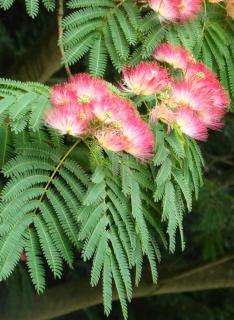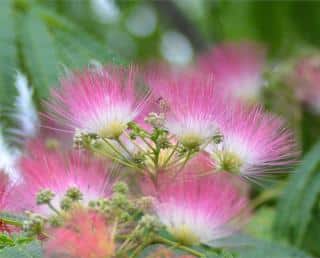

The Albizia tree is famous for its fabulous summer blooming.
A summary of Albizia facts
Name – Albizia julibrissin
Family – legume family (Fabaceae)
Type – tree
Height – 20 to 40 feet (6 to 12m)
Exposure – full sun
Soil – ordinary
Foliage – deciduous – Flowering – Summer – Invasive in – USA, Canada, Australia
Care and pruning are such actions that support the albizia’s proper blooming and growth.
Either of the following two seasons can be the right time to plant Albizia: fall or spring, preferably in a spot sheltered from wind. The most promising season that favors root development is fall, in order to promote settling in, but only if the winter weather is mild enough.
Where winters are cold, favor planting in spring in a sunny spot that is sheltered from wind, because it originally is best suited to mild temperate climate.
Albizia can hold to temperatures as low as about 22-23°F (-5°C).

Albizia is a very easy tree to grow because it requires practically no care.
If you wish to reduce the size or balance branch growth:
To enhance the albizia’s blooming, you can add granulated flower tree or shrub fertilizer in spring.
You can also simply prepare your own liquid fertilizer if you’ve got weeds in the garden you must get rid of:

This is the reason this tree is also called the “silk tree”. After being formally identified and described in the late 18th century, botanist
Filippo degli Albizzi introduced it in Europe, from whence it spread across the planet.
Another name for it is acacia tree, or sometimes also the Persian mimosa tree.
Its beauty should lead you to plant it as a standalone to best take advantage of its many appealing characteristics.
Plant albizia in full sun because it loves heat and its flowers will be even nicer!
Your comment is awaiting moderation.
I started 3 Albizia julibrissin from seeds in 2019. I potted them up all through 2019 and then transplanted them into the ground during the summer of 2020. They’ve done well so far. One of them is quite tall, over 10 feet already. When can I expect them to bloom for the first time? I’m in North Carolina, growing zone 7B.
Hi. I live in Wales and have a 10/12 foot Albizia julibressin growing in my garden which appears to be evergreen as it’s never lost its leaves. It’s a seedling from my son’s tree in France. However, the leaves are solid and not fern-like as I expected them to be. When it was a new seedling, some of the leaves were fern-like but, as it’s grown, they’ve changed. It is about 5 or 6 years old and has never flowered. Do you think it will ever bloom or am I too far north?
That’s interesting. The first thing that comes to mind is that it might be an other tree altogether, because of the solid leaves. As for the flowering, at 12 feet, you should expect some to appear this year, in my opinion. Even in Wales, the silk tree can bloom.
I have three mimosa trees that have grown very quickly over the past 2 years but all of the flowers are white with virtually no pick color. Is this just a variation of species or is there some nutrient that I could add to the soil to enhance colorful blooms?
Hello Otto, for Albizia the flower color is really related to the variety or cultivar. The white one you have must likely be the Alibizia julibrissin ‘Alba’, which has white flowers, while other cultivars might have colors such as ivory-cream or even dark pink. There isn’t much you can do to change the color, since it isn’t a problem of nutrient availability.
I have a ALBIZIA TREE, it’s leaves are turning YELLOW, it’s February in W A AUSTRALIA, WOULD IT BE GOING INTO BECOMING DECIDUOUS THE TREE IS 15 YRS OLD AND HAS JUST BEEN REPOTTED
Hi Rosslyn, I don’t think this may be the case, except if you’ve moved the pot to a new location, or if the tree was previously in the ground. Indeed, Albizia would turn deciduous if moved to colder weather, or to a more exposed / windy portion of the garden. Putting a ground-grown tree into a pot might also have that effect, as potted trees are more vulnerable to cooler temperatures than grounded ones.
Since temperatures in Western Australia have increased over the past 50 years, it wouldn’t be due to climate change.
I’d say it’s more likely the tree adjusting to the recent repotting. Sometimes when repotting, roots are disturbed and have to grow back. A good practice is to prune the branches back a bit every time you repot, so that the disturbed roots don’t have to sustain as heavy a load.
Another possibility is that a different type of soil is used, perhaps one with a higher pH (less acidic). It may be that your tree is developing chlorosis. This would also happen if watering exclusively with tap water. Since you’ve repotted, however, I don’t think chlorosis is at play.
Lastly, make sure that drainage is excellent. This means that excess water has to be able to drain away. There should be a hole in the pot, gravel to keep soil and roots from stopping the hole up, and if you’ve a saucer or tray catching excess water, then the pot shouldn’t rest on it directly but be set up higher so that water doesn’t stay in the lower part of the pot.
My Albizia has lost its leaves this month, it is in a sheltered part of the garden against a wall , is this normal?
Hi Mandy, if you’re in the Northern hemisphere and winter is coming in, yes, it’s perfectly normal. Albizia is a deciduous tree that looses its leaves in winter. The tree will go dormant and wake up again in Spring. Nothing to worry about!
Thank you for your quick response and reassurance, I do live in the north of England and i was concerned that something was wrong with my plant.
Mandy
Albizia is a weed and is often invasive in North America. It is not recommended by many Plant and Horticulture university departments anymore. I recommend you at least make a note of this on the albizia page so that you are not found supporting invasive plants. The tree is beautiful though! For a similar look, I recommend Robinia pseudoacacia (in the American Southeast) or Styphnolobium japonicum. Thanks for supporting gardening!
That’s a very helpful insight, Miles. I added that particular point in the article, readers will surely find it helpful! I also drew up a map of where Albizia is native and invasive, just to make sure it’s as clear as can be. Thanks for your own support, too!
I love the smell of the flowers. Very soft, almost like baby powder.
That’s true, but I have to admit the scent is very light. Sometimes too much wind or rain will wash it away immediately 😥